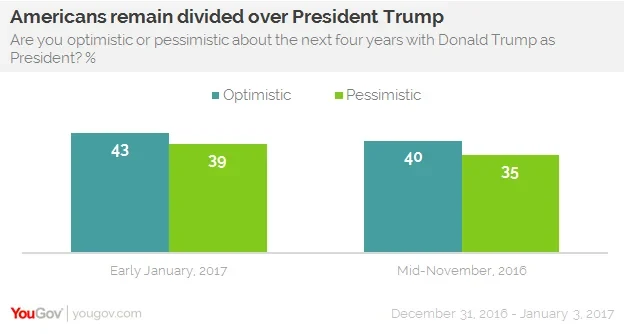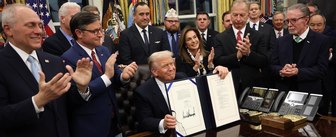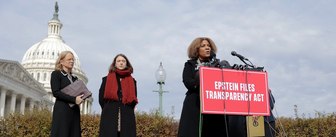While half the public can identify Obama as a liberal, Americans aren’t sure what to think about Trump
In two weeks, one President will leave and the next will enter the Oval Office. Barack Obama and Donald Trump are political opposites, and on most measures the public sees them very differently. The latest Economist/YouGov Poll shows one judged positively as he ends his time in the White House, while the other has yet to benefit from any major post-election victory bounce.
There are some big questions about the incoming President. Donald Trump has still not received a clearly positive assessment from the public. While his favorable rating has improved since the election, 51% still hold an unfavorable view of him and just 41% are favorable. In addition, there is still skepticism about his presidency and his transition, with just about as many disapproving as approving of the way he has handled the transfer of power.
Trump has not yet experienced the bump in hopeful expectations that most Presidents-elect receive, even after other hotly contested elections. After George W. Bush finally was declared the winner of the 2000 election, twice as many Americans were optimistic as pessimistic about his presidency. After the 2016 election, the public was closely divided about Trump’s presidential prospects. There has been little change in that assessment today.

On most measures, there is a big difference in assessments of Trump and Obama. The New York businessman will follow a President who was criticized but generally well-liked as a person. Obama is also viewed as caring about individuals’ needs and problems, and consistent in his policy stands. For many Americans, Trump is none of those things:
- Two-thirds of the public say they like Obama as a person (41% like him a lot), while one-quarter don’t like him at all. 46% say they dislike Trump, and just 42% like him.
- A majority say Barack Obama cares about their needs and problems, while a majority think Trump does not.
- Americans generally think that Barack Obama holds clear and consistent policy positions on the issues. But by two to one, they think Trump does not.
One particular Trump difficulty is that many Americans aren’t quite sure what he thinks. While half the public can identify President Obama as a liberal (a characterization both self-identified liberals and conservatives agree on), Americans aren’t sure what to think about Trump. Just over a third say he is conservative, but nearly as many say he is either a moderate or a liberal, and the same percentage can’t give any ideological assessment of the incoming President.

President-elect Trump is not quite all things to all people. Less than half of conservatives view him as one of them (four in ten conservatives say he is a liberal or moderate); self-described liberals and moderates are more likely to view Trump as an unknown ideological quantity.
Americans do know about the President-elect’s propensity to use Twitter to convey his positions — and many still don’t like it. In fact, Americans overall are slightly more negative about this practice than they were shortly after the election. Nearly half the public overall and nearly a third of Republicans don’t think he should be doing this.

There are some similarities in the way the public sees the two presidents. For example, in the latest Economist/YouGov Poll, just about as many Americans view each man as a strong leader (though just one in five see both that way).
In retrospect, Americans are judging President Obama more fondly than they did before the fall campaign. Evaluations of his performance have improved as he completes his second term, reaching levels not seen since his first year in office, even as he remains a divisive figure. The current President’s approval rating has been above or near 50% for most of the fall, even though only one in four have said the country is on the right track. The President had negative ratings for nearly all of the earlier part of his second term.








